Abstract
This paper investigates an information spreading mechanism under repeated judgment. In a generalized model, we prove that given a necessary condition, information under repeated judgment can sustain continuous spreading. Furthermore, we generalize the aforementioned spreading model on heterogeneous networks and calculate the analytic solution of the final state, in which spreaders finally have a stable scale to ensure that information can continuously spread when repeated judgment of information takes place. Moreover, the simulation results show that the more neighbors the spreaders have, the quicker the information vanishes. This finding suggests that in terms of information spreading under repeated judgement, it is not better to have more neighbors, quite contrary to common opinion.
MSC:
68U35; 90B50
1. Introduction
It is well-known that Nokia was, in the past, one of the best mobile brands. However, Nokia gradually lost its leading role to Apple and Samsung, who took full advantages of the smartphone trend. Currently, with the introduction of another trend of online direct sales, the competition in the mobile smartphone industry is increasingly more aggressive. To address this challenge, many suppliers face a channel distribution decision of whether to add a new retailing channel to their existing offline channels. For example, many top manufacturers, such as Apple, Cisco, Huawei, IBM, and Lenovo, have started selling directly online. What are the rationales behind such decisions of transition? In this paper, we adopt a perspective of how information spreading can help us to better understand business performance when making online/offline decisions. In this era of digital business, a crucial decision mainly depends on how much information you have, such as information about a corporation’s own strength, its rival’s reactions, and the market situation.
Digital business/economy has influenced human life greatly and is challenging traditional management theories. B2C websites allow consumers to comment on the products they have bought. Online product reviewing is one of the major components of the influence of word of mouth (IWOM), and it has a significant impact on the consumption decisions of online shoppers. Rational consumers want to maximize their utility, i.e., they consider relevant online product reviews before making a purchasing decision.
In this era of digital business, information is vital to any decision-making, and it is not an unfamiliar concept in ordinary daily life. For instance, smartphone, channel strategy, and WOM information is highly important in making decisions for both manufacturers and consumers. Obviously, information plays an important role in our daily life.
Information is a type of social contagion process through which the same or a similar remark spreads on a large scale in a short time through chains of interaction or communication. Although these problems are worthy of consideration, in this paper, a perspective of information spreading enabling us to focus on population dynamics is under investigation. Information preserves an asymptotic behavior that heavily depends on the scale of final spreaders. It is challenging to understand how information continuously spreads (see Figure 1 below).
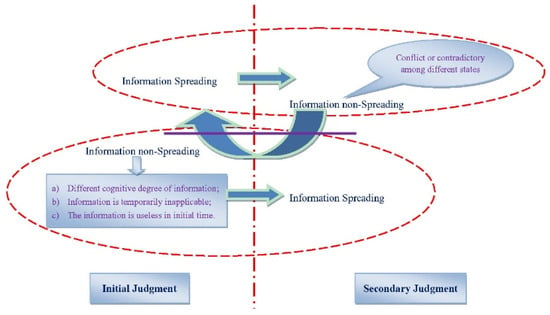
Figure 1.
Information spreading under repeated judgment.
We know the following with regard to information:
- Different cognitive degrees of information mainly depend on an individual’s educational level.
- Although it plays a critical role in purchasing decision, information value may not be fully recognized in terms of individual judgment.
- In initial judgment, users of information may find it useless, but the situation may change under repeated spreading (i.e., repeated judgment).
In the initial spreading stage of information, spreaders may behave with intense oscillation and frequent replacement. However, based on recursion, information may spread by a periodic orbit that causes the same information to spread around and begin again in one orbit, which may cease to spread eventually. How to ensure the continuous spread of information, with measures to implement repeated judgment for information and avoid recursive information, is the objective of this paper. In this study, we find that spreaders finally form a stable quantity in systems and obtain steady results from the organizational atmosphere.
As an example of social contagion processes, information spreading has attracted the interest of researchers from diverse disciplines [1,2,3,4]. Pioneering contributions to information spreading modeling based on epidemiological models date back to Trpevski et al. [5], who used the idea of information spreading to study how two different product competitors are expected to attract new users, and they found that a product with lower preference can still obtain a non-zero fraction of the market. Liu et al. [6] considered the characteristics of WOM communication and the heterogeneity of online social networks as scale-free networks. Miritello et al. [7] investigated the temporal patterns of human communication and its influence on the spreading of information in social networks and explained the opposite effects on the reach of the information, i.e., whereas bursts of anger hinder propagation at large scales, conversations favor local rapid cascades. Xu et al. [8] proposed an S-SEIR model that analyzes the influence of information value and user behavior on information dissemination on social networking services, and found that information value can benefit information audits within a certain range. Although these studies have mainly focused on the applications of information, some scholars have begun to analyze information itself via a physical model or the complex network theory [9,10,11]. For example, Cao et al. [9] established a general model by considering the level of forgetfulness during knowledge transmission in complex networks and analyzed the stability of the equilibrium points and the transmission threshold. From this angle, they used mathematical analysis through compartment models to explain information spreading. However, forgetting is an asymptotic process and its level mainly depends on the number of spreaders and the organizational atmosphere [9], and it is not completely included in the aforementioned studies.
2. Spreading Mechanism
Information spreading is similar to knowledge or rumor transmission with complex dynamic behavior. In this paper, we consider a closed system and an inhomogeneous mixed population with N individuals who can be divided into four different states, corresponding to ignorant, spreader, hibernator, and stifler, respectively.
- Ignorant. The ignorant state is comprised of individuals who have not heard of the information and are susceptible to be informed of this information.
- Spreader. Spreaders are those who spread the information.
- Hibernator. Hibernators consist of individuals who are transformed from being spreaders due to the forget mechanism and can be turned back into spreaders again based on organizational structuring. Furthermore, some hibernators will give up the information according to some reasons, such as the conflict between hibernators and other states with different cognitive degrees of information. On the other hand, information may lose its incumbent value. What is more, the rest still stays in a hibernating state.
- Stifler. Stiflers are composed of individuals who have heard of the information but do not spread it anymore.
The spreading process goes forward through direct/indirect contacts between spreaders and the rest of the population. Thus, it is possible to construct a social network G = (V, E), where V and E denote vertices and edges, respectively. The information spreading and state transition process is shown in Figure 2.
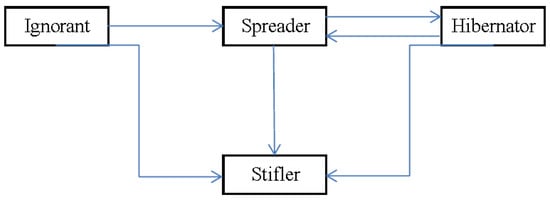
Figure 2.
Information spreading and state transition process.
Spreading can occur when an ignorant and a spreader interact, and the ignorant does not stay in the ignorant state but chooses whether to spread the information or not. It mainly depends on the ignorant person’s cognitive degree of information. In addition, in the ignorant–stifler interaction, a stifler, whether interested in the information or not, will make up his own mind to confirm if the information contains the truth. In this paper, the stiflers are very active in talking about the information [12]. When the stifler talks about the information as a precaution against its spread, he may succeed in changing the ignorant into a stifler. On the other hand, the ignorant may doubt the stifler’s words and learn to believe the information. Moreover, spreaders spontaneously forget the information and switch to the hibernator state (temporary forgetfulness) resulting from the forget mechanism. When a hibernator interacts with a spreader, despite incumbent spreaders around, the hibernator may remind himself to recall the information. When a spreader contacts other spreaders or stiflers, the former may switch to a stifler state due to the conflict among different states with different cognitive degrees of information. The same may occur for a hibernator interacting with other hibernators or stiflers.
In summary, the interactions of information spreading in this model are defined as in Table 1 (I = ignorant, S = spreader, H = hibernator, R = stifler).

Table 1.
Definition of the interactions during information spreading for state transition.
3. Methods—A Generalized Model
The contact rate is the frequency at which a spreader contacts others in a unit of time, commonly depending on the total number of populations , denoted by . Spreading may occur if an ignorant interacts with a spreader. Assuming that the probability of contact spread is , the contact rate is modified by β0U(N), i.e., the adequate contact rate. The ratio of ignorants in the population is and a spreader’s average spreading rate to ignorants is , then the number of new spreaders (i.e., the number of ignorants who are infected by all incumbent spreaders) at time is , which is referred to as incidence.
In fact, because the quantity at which a spreader contacts others in a unit of time is limited when the number of populations is very large (), we can assume that the contact rate is a constant rather than . Furthermore, the effective contact rate can be redefined as , and information incidence is viewed as , which is defined as standard incidence. Our model adopts “standard incidence” throughout the paper, and Table 2 summarizes the resting parameters and decision variables in the proposed model.

Table 2.
Definitions for key parameters and dynamic variables.
3.1. Modeling and Analysis
Combining research background and spreading mechanism, the spreading model in the framework of differential dynamic system is as follows:
In order to carry out the mathematical analysis, we set the following assumptions:
- (a)
- , are strictly positive.
- (b)
- , , and .
- (c)
- , , , are nonnegative.
Following Driessche and Watmough [13], the progression from H to S and failures of transmission are not considered to be new spreaders, but rather the progression of a spreader through the various compartments. Hence,
where is the rate of appearance of new spreaders, and is the rate of transfer to other individuals.
The spreader compartments are H and S, giving n = 2. Without loss of generality, the point (S, H, I, R) = (0,0,1,0) is the information-free equilibrium (IFE). Then
giving
As a well-known concept, the basic reproduction number, denoted , is the ‘expected number of secondary cases produced, in a completely ignorant population, by a typical spreading individual’ [14]. Following Diekmann et al., we call the next generation matrix for the system (1) and set , i.e., is the maximum spectral radius of the matrix . In addition, we can calculate the spread threshold of system (1) in the following way:
Proposition 1.
If, then the information-endemic equilibrium (IEE) of system (1) exists, which means that information has to be spread.
From Proposition 1, it could be verified when the information can achieve spreading. Furthermore, in order to depict information on how to perform repeated judgment in the spreading process, incumbent system needs to make some changes.
Let , , , and be the density of Ignorant, Spreader, Hibernator, and Stifler, respectively, i.e.,
and . Thus, the incumbent system (1) can be redefined as follows:
Due to being a closed system, the above system is equivalent to a cubic system as follows:
and a positive invariant set with respect to system (3) is
Furthermore, let , and
then we can calculate that
Thus, the Dulac criterion [15] is applied to deduce that the domain does not contain any periodic orbits or cyclic chains of system (3). Indeed, we can easily rule out the periodic orbits containing points on the coordinate axes. Then, the periodic orbits of system (3) are not contained in domain .
Proposition 2.
Information can achieve sustained spread, i.e., information with repeated judgment really exists, which can result from system (3) that does not have any periodic orbits or cyclic chains in domain .
3.2. Threshold under Utility Function
Although we have used constant parameters in our models for simplicity, it is more realistic to define parameters as functions of population frequencies. In this section, we attempt to derive some complex relations between population frequencies with the forget mechanism and utility function that determine individual behavior.
A simpler form of utility function was first introduced in models with two products [16]. It has since been widely utilized in the economics, marketing, and operations management literature [17,18]. The utility function also encompasses the classical economic features of diminishing marginal rates of substitution and diminishing marginal utility. In this paper, the utility function of a representative consumer is expressed from the perspective of aggregated demand as follows (for more properties of this utility function, refer to the study by Ingene and Parry [19]):
where denotes the product substitutability, is the nominal demand for product assuming the price is zero, is the realized demand of product , and is the retail price of product . This utility function also implicitly assumes that the consumer has sufficient budget to purchase the product.
As information can be viewed as a type of common product to be handled, the demand for information mainly depends on the quantity of different compartments (i.e., ). For this model-based approach, we simply assume the following:
- (a)
- utility decreasing of ignorants and utility increasing of stiflers are not considered due to double marginalization.
- (b)
- hibernators consider the forget mechanism.
Thus, we can modify the aforementioned utility function as follows:
without loss of generality. Maximizing Equation (4) yields the utility performance for each compartment as follows:
When an individual belongs to a large group, it would suffice for him, which motivates him to maintain and enlarge his group [12]. Considering a spreader decides whether to talk about the information with a partner whose state is unknown and assuming that the spreader will gain positive psychological expectation if the partner gives feedback, such as believing the information or being amused by it, the internal spreader would have enough power to attain other states to accept the information, or the external information is sufficiently “attractive” (believable, worthy spread, etc.). Conversely, the spreader gains negative psychological expectation , if the partner gives feedback, such as denying it or giving a different cognitive degree of information resulting in conflict. In fact, the spreader may deduce the partner’s feedback from the utility compartment , and the attractiveness of the information is .
If the spreader successfully switches a susceptible listener to a new spreader with probability , the utility of the spreader compartment will increase by 1, i.e., Us + 1. However, when two spreaders interact, the latter may leave a spread compartment with probability , and the utility of other compartments, except spread , will increase by 1, i.e., . In other cases, the utility will not change. The payoffs of one spreader are summarized in Table 3.

Table 3.
A payoff matrix for information spread.
If the spreader does not talk about the information, his psychological expectation will not change. If he talks about it, the expected increment of his psychological expectation considering the spreader’s utility is denoted by
Thus, we can obtain
when .
Proposition 3.
The supremum of spreaders (
) is a necessary condition for repeated judgment of information. If all members of the population in the system have become spreaders, it is not necessary to spread, because all of them have heard about the information.
3.3. Numerical Simulations and Discussions
For information spreading, we have already analyzed its repeated judgment in the spreading process. Here, we will present numerical simulations to investigate the properties of information spreading model like system (1), and we assume that there are (without loss of generality) individuals in this closed system. Moreover, the parameters are assumed as follows: and (the stiflers are very active to talk about the information as mentioned above); and according to the assumption; ; due to the forget mechanism; and as the result from the organizational atmosphere. At the same time, the initial values of system (1) are which are much closer to reality when .
As depicted in Figure 3, due to the different interactions among different compartments, the spreaders will become stiflers at a given rate and all the ignorant persons will disappear, i.e., the entire population has heard the information. The major difference is whether to spread it or not. In the long run, the hibernators lastly have a stable scale, although the ratio of H is smaller. Moreover, this situation may guarantee an accelerated spread of information. Figure 3a depicts how spreaders change with repeated judgment. In the initial judgment, spreaders increase until a peak is reached. Conversely, the information comprehension of spreaders is more rational, which may result in frequent replacement until a stability is reached via a second repeated judgment. The more repeated the judgment of the information, the more stable the number of spreaders.
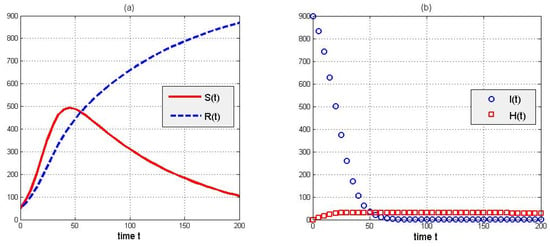
Figure 3.
(a) The time series for spreaders and stiflers under ; (b) The time series for ignorants and hibernators under .
Figure 4a depicts that limit cycles (i.e., periodic orbits or cyclic chains) do not exist in the phase diagram of , which is a necessary condition for the information’s repeated judgment. In addition, Figure 4b investigates how the final size of spreaders changes under different initial values. Obviously, the size of spreaders is asymptotically stable in the long term even though the initial quantities of spreaders are different. Figure 4b proves that the information-endemic equilibrium (IEE) is globally stable when .
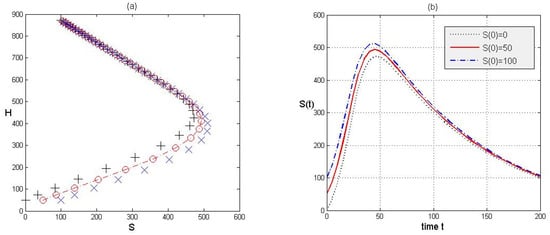
Figure 4.
(a) The phase diagram for spreaders and hibernators in ; (b) The time series for spreaders with different initial value under , respectively.
Figure 5a depicts the influence of spread velocity on the spreaders’ scale, so we can adjust these two parameters to sustain the number of spreaders. Figure 5b reveals that the smaller is, the larger the number of spreaders is. After all, an organization has adequate power to maximize the recovery of the hibernator compartment. Figure 5b also depicts the influence of the forget mechanism on information spreading. Forget is an inevitable phenomenon; however, we can effectively control the forget probability to enhance information spreading. In short, the better the organizational atmosphere, the quicker the spreading velocity.
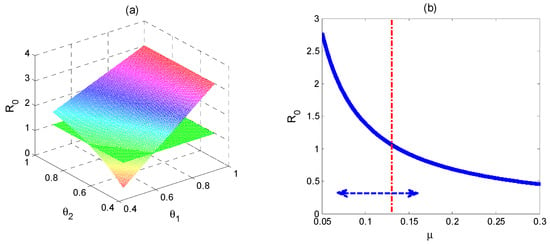
Figure 5.
(a) The tendency of information spreading considering spread velocity; (b) Information spreading under the forget mechanism.
4. Methods—A Dynamic Model Considering Heterogeneous Networks
In Section 3, we prove the possibility of information’s repeated judgment. Giving the infimum of system (1) via the next-generation matrix, we also adopt a utility function that considers a static game to obtain the supremum. Next, we generalize this model on heterogeneous networks to investigate the dynamic behaviors of information. Here, we theoretically calculate the analytical solution of the network model and provide some numerical simulations to further explain some management suggestions.
4.1. Abbreviations and Acronyms
By combining system (1) and complex networks, the mean-field equations can be redefined as follows:
and conditional probability is a given ignorant with which randomly chooses an edge and points to a spreader with .
In a similar way, let ,, , and be the density of Ignorant, Spreader, Hibernator, and Stifler, respectively, i.e.,
and , , and . Thus, the incumbent system (5) can be redefined as follows:
Suppose the network is uncorrelated, then the conditional probability p(k′|k) is independent of k. Therefore, the conditional probability takes the form [20], where is the mean-degree (or first moment) of the network.
For convenience of calculation, we introduce auxiliary functions as follows:
with the shortened form .
Equation (6) can be directly integrated as , and let initial distribution without loss of generality. Next, multiply Equation (7) with , sum over and integrate the equation with respect to , we can obtain
As for Equation (9), in a similar way, we can also calculate
In the long run, and are constant. That means and when . For the above purpose, we can obtain
while assuming for simplicity. From Equation (8)
By solving the one order non-homogeneous differential equation, it directly leads to
where is the leading order of in .
By using the theory of ordinary differential equations, Equations (7) and (8) can be directly solved in the following ways:
, furthermore,
Inserting Equation (13) in Equation (12), we can derive the expression of as
and
with Taylor expansion. , will be in stationary solution, on the other hand, when close to the spread threshold . Asserting and , where is a finite function.
Afterwards, inserting Equation (14) in Equation (10) to solve
and , , .
In an ideal case, we may assume that , i.e., all of the people have heard of the information, and the key lies in whether spreading it or not. Thus, we can calculate and , respectively;
4.2. Numerical Simulations and Discussions
This section will present some numerical simulations to interpret the dynamic behaviors of the system (5). Additionally, the simulations are based on a ‘scale-free’ network [21] with the power-law distribution takes the form , where , and is the minimum degree of the network. The parameters’ setting is same as Section 3.3.
Figure 6a depicts the influence of the neighbors of spreaders on information spreading. It is obvious that the more the neighbors of spreaders, the less the scale of the final spreaders. Contradictions increase when more people are around the spreaders, thus the quantity of spreaders leads to intense oscillation, and the system (5) is more vulnerable. Over time, the spreaders finally obtain a stable scale to ensure the continuous spread of information when a repeated judgment of information takes place, which is depicted in Figure 6b. Moreover, these numerical results can be verified by the analytical solution of Equation (15).
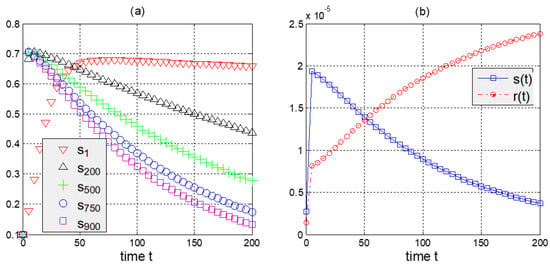
Figure 6.
(a) The time series for spreaders with different degree () in , respectively; (b) The time series for the densities of spreaders and stiflers with .
As administrators, it is more important to set up effective neighbors of information management, rather than to adopt the idea of the more the better.
5. Conclusions
This study investigates the impact of repeated judgment and the forgetting mechanism on information spreading. Unlike previous studies on information spreading, our study concentrates on the mathematical analysis of a network model and provides some necessary conditions to explain how information continuously spread.
- (a)
- For continuous inheritance and innovation of information, as a spread threshold has to meet , which mainly depends on the definition of the basic reproduction number; otherwise, it will completely extinct.
- (b)
- As rational consumers, people always expect to maximize their utility whenever they purchase. Based on this theory, we apply the utility function to obtain spreaders’ supremum .
- (c)
- Spreading can occur only when spreaders and other individuals contact and interact, implying that individuals from different orbits need to interact. Thus, periodic orbits or cyclic chains do not exist; otherwise, we cannot carry out repeated judgments of information.
When conditions (a) and (b) are satisfied, information undoubtedly can spread. Information value is manifested during the process of information spread. As for the information itself, it demonstrates different behaviors under different spreading stages, and Figure 1 depicts some interpretations in detail. In Figure 1, we take the repeated judgment of information as an example, and the reason why this phenomenon occurs is non-recursion of information judgment, i.e., no periodic orbits or cyclic chains exist in our model.
Forget is an inherent characteristic of information, which is the so-called vulnerability. It is worthwhile to enhance the robustness of the information-spreading process. From a technical perspective, we can strengthen repeated judgment of information. In addition, an organization as a whole may build a long-term effective learning atmosphere. One way is to encourage active efforts and self-improvement of members, and enhancing active communications among members is another way. In conclusion, we must establish an effective information judgment mechanism in the organization.
In the network model of information spreading, the number of neighbors of a node has a huge impact on information spreading, except for the forgetting mechanism, i.e., as the number of neighbors around one node increases, the spread velocity decreases. This is because conflicts are exposed when more neighbors are around one node, which results in more people choosing to give up the information. Then, as a rational administrator, one needs to effectively control the above phenomenon to implement information management. After all, the number of neighbors of one people is not the more the better, contrary to the common sense of the principle of “six degrees of separation”.
People expect information (distinct from rumors) to have a faster spreading velocity, so it can help an organization to establish a better learning atmosphere. It can also gain advantages in making decisions for better operational management.
Author Contributions
B.C., Conceptualization, Funding acquisition, Methodology, Software, Formal analysis, Model-setting, Writing—original draft, and Writing—review and editing; Y.F., Methodology, Writing—original draft, and Writing—review and editing; W.Z., Visualization and Supervision; Z.L., Conceptualization, Supervision, Methodology, Validation, and Writing—review and editing. All authors have read and agreed to the published version of the manuscript.
Funding
This research was partially funded by the Guangdong Universities Special Key Project (Project No. 2021ZDZX3021); the Guangdong Higher Education Curriculum Development and Teaching Enhancement (Project No. UICR04000052-21CTL); the Ministry of Education of Humanities and Social Science project (19YJC630035, 21YJC630002); the Natural Science Basic Research Program of Shaanxi (2020JQ-688, 2021JM-379); the Scientific Research Program Funded by Shaanxi Provincial Education Department (20JK0704); the Project of the Key Research Base for Philosophy and Social Sciences in Shaanxi (20JZ065); and the Project funded by China Postdoctoral Science Foundation (2019M653574).
Institutional Review Board Statement
Not applicable.
Informed Consent Statement
Not applicable.
Data Availability Statement
Not applicable.
Conflicts of Interest
The authors declare no conflict of interest.
References
- Hosseini-Pozveh, M.; Zamanifar, K.; Naghsh-Nilchi, A.R. Assessing information diffusion models for influence maximization in signed social networks. Expert Syst. Appl. 2019, 119, 476–490. [Google Scholar] [CrossRef]
- Hu, Y.; Song, R.J.; Chen, M. Modeling for information diffusion in online social networks via hydrodynamics. IEEE Access 2017, 5, 128–135. [Google Scholar] [CrossRef]
- Kawamoto, T.; Hatano, N. Viral spreading of daily information in online social networks. Phys. A Stat. Mech. Its Appl. 2014, 406, 34–41. [Google Scholar] [CrossRef]
- Yang, D.; Liao, X.; Shen, H.; Cheng, X.; Chen, G. Modeling the reemergence of information diffusion in social network. Phys. A Stat. Mech. Its Appl. 2018, 490, 1493–1500. [Google Scholar] [CrossRef]
- Trpevski, D.; Tang, W.K.S.; Kocarev, L. An opinion disseminating model for market penetration in social networks. Proceedings of 2010 IEEE International Symposium on Circuits and Systems, Paris, France, 30 May–2 June 2010; pp. 413–416. [Google Scholar]
- Liu, C.; Zhan, X.X.; Zhang, Z.K.; Sun, G.Q.; Hui, P.M. How events determine spreading patterns: Information transmission via internal and external influences on social networks. New J. Phys. 2015, 17, 113045. [Google Scholar] [CrossRef]
- Miritello, G.; Moro, E.; Lara, R. Dynamical strength of social ties in information spreading. Phys. Rev. E 2011, 83, 045102. [Google Scholar] [CrossRef]
- Xu, R.Z.; Li, H.L.; Xing, C.M. Research on information dissemination model for social networking services. Int. J. Comput. Sci. Appl. 2013, 2, 1–6. [Google Scholar]
- Cao, B.; Han, S.; Jin, Z. Modeling of knowledge transmission by considering the level of forgetfulness in complex networks. Phys. A Stat. Mech. Its Appl. 2016, 451, 277–287. [Google Scholar] [CrossRef]
- Shioda, S.; Nakajima, K.; Minamikawa, M. Information spread across social network services with non-responsiveness of individual users. Computers 2020, 9, 65. [Google Scholar] [CrossRef]
- Zhang, Z.K.; Liu, C.; Zhan, X.X.; Lu, X.; Zhang, C.X.; Zhang, Y.C. Dynamics of information diffusion and its applications on complex networks. Phys. Rep. 2016, 651, 1–34. [Google Scholar] [CrossRef]
- Kawachi, K.; Seki, M.; Yoshida, H.; Otake, Y.; Warashina, K.; Ueda, H. A rumor transmission model with various contact interactions. J. Theor. Biol. 2008, 253, 55–60. [Google Scholar] [CrossRef] [PubMed]
- Van den Driessche, P.; Watmough, J. Reproduction numbers and sub-threshold endemic equilibria for compartmental models of disease transmission. Math. Biosci. 2002, 180, 29–48. [Google Scholar] [CrossRef] [PubMed]
- Diekmann, O.; Heesterbeek, J.A.P.; Metz, J.A.J. On the definition and the computation of the basic reproduction ratio R0 in models for infectious diseases in heterogeneous populations. J. Math. Biol. 1990, 28, 365–382. [Google Scholar] [CrossRef] [PubMed]
- Fiedler, B.; Hsu, S.B. Non-periodicity in chemostat equations: A multi-dimensional negative Bendixson–Dulac criterion. J. Math. Biol. 2009, 59, 233. [Google Scholar] [CrossRef] [PubMed]
- Cai, G.G.; Dai, Y.; Zhang, W. Modeling multichannel supply chain management with marketing mixes: A survey. In Handbook of Research on Distribution Channels; Edward Elgar Publishing: Cheltenham, UK, 2019. [Google Scholar]
- Cao, B.; Zhang, Q.; Cao, M. Optimizing Hybrid-Channel Supply Chains with Promotional Effort and Differential Product Quality: A Game-Theoretic Analysis. Mathematics 2022, 10, 1798. [Google Scholar] [CrossRef]
- Fu, Y.; Gu, B.; Xie, Y.; Ye, J.; Cao, B. Channel structure and differential pricing strategies in dual-channel e-retail considering e-platform business models. IMA J. Manag. Math. 2021, 32, 91–114. [Google Scholar] [CrossRef]
- Ingene, C.A.; Parry, M.E. Mathematical Models of Distribution Channels; Springer Science & Business Media: Berlin/Heidelberg, Germany, 2004. [Google Scholar]
- Pastor-Satorras, R.; Vespignani, A. Evolution and Structure of the Internet: A Statistical Physics Approach; Cambridge University Press: Cambridge, UK, 2004. [Google Scholar]
- Albert, R.; Barabási, A.L. Statistical mechanics of complex networks. Rev. Mod. Phys. 2002, 74, 47. [Google Scholar] [CrossRef]
Publisher’s Note: MDPI stays neutral with regard to jurisdictional claims in published maps and institutional affiliations. |
© 2022 by the authors. Licensee MDPI, Basel, Switzerland. This article is an open access article distributed under the terms and conditions of the Creative Commons Attribution (CC BY) license (https://creativecommons.org/licenses/by/4.0/).